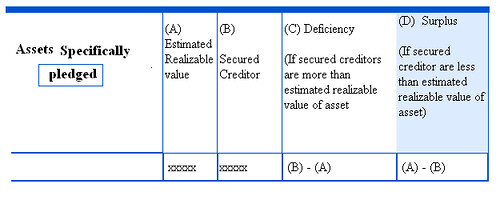At the time of liquidation of company, a very important statement is made for showing estimated realizable value and liabilities expected to rank. That statement is called statement of affairs. To prepare statement of affairs is also important because by making statement of affairs we can know what amount of surplus or deficiency in balance. Company act 1956 has given its format. Different items are estimated as per different lists. Now, we are preparing and explaining statement of affairs according to list of assets and liabilities. You should remember statement of affairs all item thoroughly. Difference between the estimated value of assets and liabilities will be estimated value of surplus or deficiency.
1. List A : Assets not specifically pledged
First of all, we make the list of assets which are not on pledge. you should not take any loan by giving these assets as security. We write these assets' estimated realizable value instead of book value because creditors are interested to know what amount will they receive after selling of these assets in market. Value of call in area will be assets under list A.In these assets, we can include
i) Balance at bank
ii)) Cash in hand
iii) Marketable Securities
iv) Bills Receivable
v) Trade Debtors
vi) Loan and Advance
vii) Unpaid calls
viii) Stock in trade
ix) Freehold property
x) Leasehold property
xi) Plant and property
xii) Furniture Fittings, Utensils etc
xiii) Investment other than marketable securities
xiv ) Livestock
xv) Other property
2. List B : Assets Specifically Pledged
In list B, we include estimated realizable value of all the assets specially mortgaged, pledged, or otherwise given as security. We also classify these pledged assets into under possession of company and not under the possession of company. We will calculate surplus or deficiency after deducting these assets' estimated realizable value from amount of secured loan and then adjusted it in estimated realizable value of assets which are not pledged.

3. List C : Preferential Creditors
Now, we deduct preference creditors of list C from the total of List A and List B amount
4. List D : Debenture holders Secured by a floating charges
The balance after deducting list c preference creditors is used for deducting the amount of debentures secured by a floating charges and its payable interest.
5. List E : Unsecured Creditors
The balance of assets after deducting list d debenture holders amount is used for deducting the amount of unsecured creditors.
6. List F : Preference Shares
In this list, we include all the payable amount of preference shares which is deducted from realizable asset's balance after deducting list E's liability.
7. List G : Equity Shares
In this list, we include all the payable amount of equity shareholders which is deducted from realizable asset's balance after deducting List F's liability. For calculating equity shares exact value, we deduct irrecoverable unpaid calls.
8. List H : Surplus or Deficiency
Balance will be surplus or deficiency which will be included in list H
1. List A : Assets not specifically pledged
First of all, we make the list of assets which are not on pledge. you should not take any loan by giving these assets as security. We write these assets' estimated realizable value instead of book value because creditors are interested to know what amount will they receive after selling of these assets in market. Value of call in area will be assets under list A.In these assets, we can include
i) Balance at bank
ii)) Cash in hand
iii) Marketable Securities
iv) Bills Receivable
v) Trade Debtors
vi) Loan and Advance
vii) Unpaid calls
viii) Stock in trade
ix) Freehold property
x) Leasehold property
xi) Plant and property
xii) Furniture Fittings, Utensils etc
xiii) Investment other than marketable securities
xiv ) Livestock
xv) Other property
2. List B : Assets Specifically Pledged
In list B, we include estimated realizable value of all the assets specially mortgaged, pledged, or otherwise given as security. We also classify these pledged assets into under possession of company and not under the possession of company. We will calculate surplus or deficiency after deducting these assets' estimated realizable value from amount of secured loan and then adjusted it in estimated realizable value of assets which are not pledged.

3. List C : Preferential Creditors
Now, we deduct preference creditors of list C from the total of List A and List B amount
4. List D : Debenture holders Secured by a floating charges
The balance after deducting list c preference creditors is used for deducting the amount of debentures secured by a floating charges and its payable interest.
5. List E : Unsecured Creditors
The balance of assets after deducting list d debenture holders amount is used for deducting the amount of unsecured creditors.
6. List F : Preference Shares
In this list, we include all the payable amount of preference shares which is deducted from realizable asset's balance after deducting list E's liability.
7. List G : Equity Shares
In this list, we include all the payable amount of equity shareholders which is deducted from realizable asset's balance after deducting List F's liability. For calculating equity shares exact value, we deduct irrecoverable unpaid calls.
8. List H : Surplus or Deficiency
Balance will be surplus or deficiency which will be included in list H
No comments:
Post a Comment